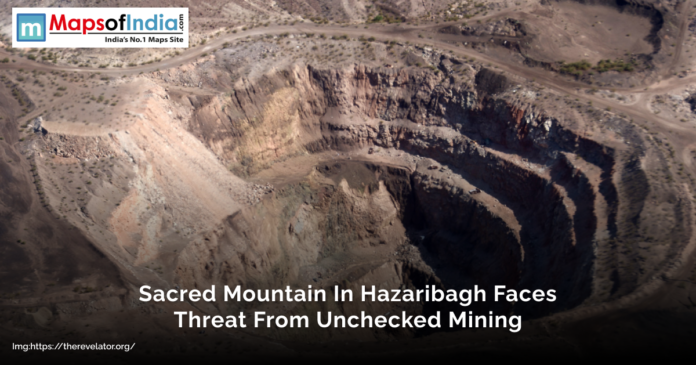In Hazaribagh, there exists a mountain that has been used for centuries as a cultural pride and object of worship by the local villagers; this mountain happens to be under serious threat. The hill has been a revered site across generations and is fast turning hollow inside as the mass-scale machine-headed mining operations have never ceased. The place, which used to be considered of spiritual value and a beautiful place of nature, is now characterized by the frequent noise of excavators and drillers, which not only frightens people living there but also causes concern among environmentalists.
To the local people of the neighbouring villages, the mountain is much more than a natural object; it is a holy landmark highly held in their tradition as well as a religious site. Rituals, seasonal festivals and gatherings of the community have long been organized at its base. Most of the locals feel that the hill is a guardian of the land, and destroying such is comparable to offending a guardian spirit. But over the last few years, the entry into the field of heavy machinery has changed the tone and dynamics of resource extraction. The small-scale, hand-powered stone cutting that was usual has now transformed into long, extensive mechanical excavations, hollowing out the very core of the mountain, then causing fluctuations when it becomes even more unstable.
Professionals are saying that hollowing of the hill is becoming a major geological danger. The instability of its interior design might eventually lead to collapse, a situation that will put in jeopardy the homes of residents, cultivating land and even persons working in the mine. According to environmentalists, above the physical danger, there is the loss of a very important cultural as well as ecological asset due to the loss of the mountain.
Villagers have been complaining to authorities time and again in the hope that they might stop or control the mining activities through protest and submission of petitions. They argue that the activities today not only contravene the environmental protection systems but also ignore the heritage status of the mountain in the minds of the community. Nonetheless, activities have not come to a halt since construction materials are in big demand.
The case has triggered a bigger discussion of the tradeoff between cultural survival and economic benefit. Although mining has its effect of direct monetary gain in the short term, concerned groups and citizens are emphasizing that once the natural landmark has been lost forever, it will not be possible to reclaim it. They demand that drastic intervention must be made promptly, that the rules on mining must be better enforced and that sustainable alternatives that do not harm livelihoods or scenery should be fostered.
To the people of Hazaribagh, preserving an object of nature to them is not merely conservation of the mountain, but it is the preservation of a symbol of their community, history, and religion. That very symbol grows nearer and nearer to downfall, with each day of digging, both in the real and in the spiritual sense.










